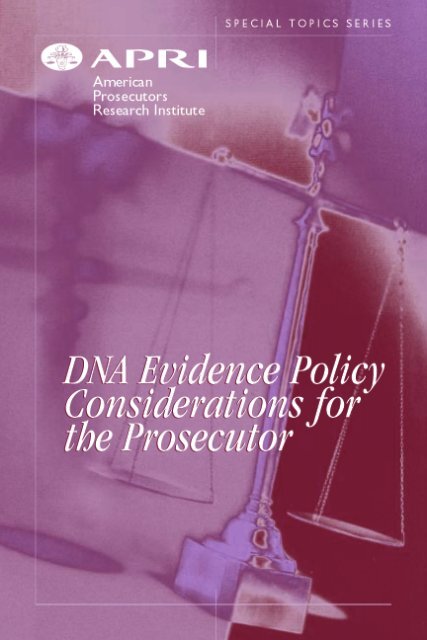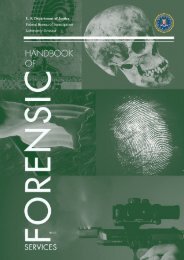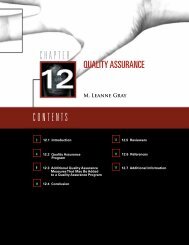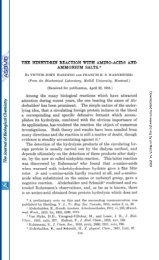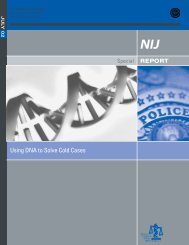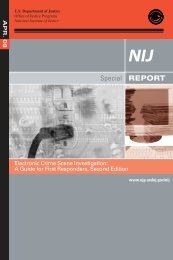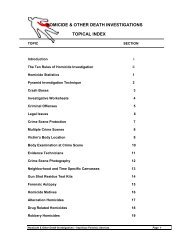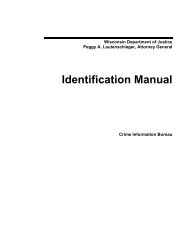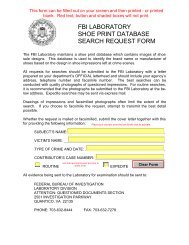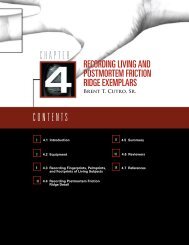DNA EVidence Policy Considerations for the Prosecutor - Imprimus ...
DNA EVidence Policy Considerations for the Prosecutor - Imprimus ...
DNA EVidence Policy Considerations for the Prosecutor - Imprimus ...
- No tags were found...
Create successful ePaper yourself
Turn your PDF publications into a flip-book with our unique Google optimized e-Paper software.
American <strong>Prosecutor</strong>s Research Institute99 Canal Center Plaza, Suite 510Alexandria,VA 22314www.ndaa-apri.orgThomas J. CharronPresidentDebra WhitcombActing Chief AdministratorDirector, Grant Programs and DevelopmentGeorge RossDirector, Grants ManagementThis in<strong>for</strong>mation is offered <strong>for</strong> educational purposes only and is not legal advice.This project wassupported by Award No. 2002-DD-BX-0005, from <strong>the</strong> Bureau of Justice Assistance, U.S.Department of Justice. Points of view or opinions expressed in this document are those of <strong>the</strong>authors and do not necessarily represent <strong>the</strong> official position of <strong>the</strong> United States Department ofJustice, <strong>the</strong> Bureau of Justice Assistance, <strong>the</strong> National District Attorneys Association or <strong>the</strong>American <strong>Prosecutor</strong>s Research Institute.The American <strong>Prosecutor</strong>s Research Institute is <strong>the</strong> nonprofit research, training and technicalassistance affiliate of <strong>the</strong> National District Attorneys Association.
SPECIAL TOPICS SERIES<strong>DNA</strong> Evidence <strong>Policy</strong><strong>Considerations</strong> <strong>for</strong><strong>the</strong> <strong>Prosecutor</strong>September 2004Lisa R. Kreeger, Senior AttorneyDanielle M.Weiss, Staff AttorneyAmerican <strong>Prosecutor</strong>s Research Institute
I NTRODUCTION<strong>DNA</strong> evidence catapulted criminal justice into a new era. Never be<strong>for</strong>ehave prosecutors had a more powerful tool at <strong>the</strong>ir disposal <strong>for</strong> determining<strong>the</strong> identity of persons who commit crime.There are few techniquesin <strong>the</strong> history of <strong>for</strong>ensic science that have been more thoroughly scrutinizedand validated than <strong>for</strong>ensic <strong>DNA</strong> testing. 1Developing specific policies <strong>for</strong> utilizing <strong>DNA</strong> evidence can help prosecutorsand law en<strong>for</strong>cement officials establish priorities and avoid pitfalls.When policies are developed proactively, <strong>the</strong>y enable localities to respondappropriately to <strong>the</strong> challenges presented by <strong>DNA</strong> evidence.Implementation of policies reduces <strong>the</strong> likelihood of wasted resources,unnecessary litigation and, most importantly, erosion of public confidence.At <strong>the</strong> same time, implementation of policies enhances <strong>the</strong> overallfairness of <strong>the</strong> adjudicatory process.In November 2003, <strong>the</strong> American <strong>Prosecutor</strong>s Research Institute (APRI)brought toge<strong>the</strong>r over 200 prosecutors, law en<strong>for</strong>cement officers, <strong>DNA</strong>analysts, Sexual Assault Nurse Examiners (SANE) and o<strong>the</strong>r criminal justicecommunity members <strong>for</strong> a two-and-a-half-day conference.Conference participants discussed and evaluated different approachesregarding <strong>DNA</strong> evidence and <strong>the</strong> maximization of both resources andprobative value. Attendees identified recurrent issues and potential policyresponses.This monograph summarizes key points that were made at <strong>the</strong> conference,offers options <strong>for</strong> developing policy and identifies critical issues toconsider. It brings toge<strong>the</strong>r several promising policy ideas that jurisdictionsmay implement or modify to fit <strong>the</strong>ir unique needs and capabilities.All of <strong>the</strong> policies developed at <strong>the</strong> APRI conference share two commondenominators: First, <strong>the</strong>y are sensitive to <strong>the</strong> specific needs of differentjurisdictions, with <strong>the</strong>ir differing populations, caseloads and resources. A1 Hogan, S. and Swinton, S.“Meeting Defense Challenges to <strong>DNA</strong> Evidence,” APRISilent Witness 15(1)(2003).1
<strong>DNA</strong> EVIDENCE P OLICY C ONSIDERATIONS FOR THE P ROSECUTORsmall jurisdiction with one central state laboratory will have differentneeds than a large jurisdiction with a large backlog of cold cases and anetwork of state-supported laboratories.Second, <strong>the</strong>y involve <strong>the</strong> participation of law en<strong>for</strong>cement agencies,SANE examiners, prosecutors’ offices, and labs.Without <strong>the</strong>ir participationand cooperation, success of <strong>the</strong>se policies is unlikely. However, <strong>the</strong>cooperative development of appropriate policies with regard to <strong>the</strong> identification,collection, development, discovery and use of <strong>DNA</strong> evidencewill allow <strong>for</strong> <strong>the</strong> elimination of backlog, expeditious case managementand successful prosecutions—in short, achieving <strong>the</strong> full potential that<strong>DNA</strong> evidence has to offer.Specifically, it is essential to develop policies that set up a triage systemwith regard to <strong>the</strong> appropriateness of <strong>the</strong> use of <strong>DNA</strong> evidence in (1)new cases, (2) suspect-less cases and (3) collaterally-attacked closed cases.It is equally important to develop policies that address <strong>the</strong> way that relevantagencies will respond to defense discovery requests. Each of <strong>the</strong>seissues is discussed below. (Sample policies are accessible on-line atwww.ndaa-apri.org; see Appendix A.)2 A MERICAN P R OSECUTORS R ESEARCH I NSTITUTE
N EWC ASESNew cases are defined as those cases in which <strong>the</strong> offense has beennewly detected but <strong>the</strong> perpetrator has not yet been charged.With regardto new cases, participants at <strong>the</strong> APRI conference identified two issuesthat would most benefit from policy development:• Early case evaluation (or evidence review)• DiscoveryEarly Case Evaluation By A Multidisciplinary TeamCase evaluation, or evidentiary review, improves <strong>the</strong> management of currentcases containing biological evidence and caseloads. For some jurisdictions,<strong>the</strong> concept of multidisciplinary case review is novel. O<strong>the</strong>rshave successfully employed multidisciplinary case evidence review <strong>for</strong>years.Some kinds of cases–such as child sexual abuse or homicide–have historicallyused multidisciplinary evidence reviews, because communicationand early analysis produce both a stronger case-in-chief and a strongerrebuttal to whatever defense is proffered.With technological advancements,nei<strong>the</strong>r time nor distance should impede a coordinated and comprehensivereview of any recently discovered violent crime. In contrast,lack of communication and organization can become very costly, both to<strong>the</strong> case and to <strong>the</strong> agencies within <strong>the</strong> <strong>for</strong>ensic community, especiallywhen unnecessary testing diverts valuable time and money or necessarytesting is not done timely if at all.In evaluating every case, prosecutors, police and <strong>for</strong>ensic scientists orcriminalists should determine what evidence is probative of <strong>the</strong> defendant’sguilt.This evidentiary or case review should be a collaborativeprocess. By reviewing cases as soon as possible after a crime has beendiscovered, <strong>the</strong> panel can identify which pieces of evidence are amenableto <strong>DNA</strong> testing, which have <strong>the</strong> most probative value, and/or whichshould be tested first.3
<strong>DNA</strong> EVIDENCE P OLICY C ONSIDERATIONS FOR THE P ROSECUTORThe case review panel must also identify potential defenses, which willhelp determine <strong>the</strong> appropriate testing to better challenge untrue defenses.For example, testing may be relevant in homicide cases in which <strong>the</strong>anticipated defense is <strong>the</strong> justified use of deadly <strong>for</strong>ce (or self-defense), tocorroborate <strong>the</strong> physical evidence or eyewitnesses, or in a sexual assaultcase to corroborate <strong>the</strong> victim’s account that <strong>the</strong>re were two assailantsinvolved in <strong>the</strong> offense, or to compare <strong>the</strong> location of <strong>the</strong> <strong>DNA</strong> mixtureswith <strong>the</strong> victim’s account of <strong>the</strong> offense. Finally, a multidisciplinary casereview allows all of <strong>the</strong> respective parties in a case to understand, documentin reports and testify accurately about why certain items were, orwere not, tested. Avoiding unnecessary testing of evidence reduces <strong>the</strong>strain on laboratory resources and frees up those resources <strong>for</strong> moreappropriate use.Case review policy should include assigning and determining communicationresponsibilities and methods, so that everyone is clear about whichagency must notify <strong>the</strong> review committee, which types of cases shouldreceive automatic case review, and timelines. Departments or agencies canevaluate <strong>the</strong> listed evidence and decide, ei<strong>the</strong>r be<strong>for</strong>e it is sent to <strong>the</strong> lab orafter <strong>the</strong> lab verifies receipt, whe<strong>the</strong>r all or part of <strong>the</strong> evidence on <strong>the</strong> listshould be tested. Jurisdictions have employed different methods to accomplish<strong>the</strong>se goals.A case review team could meet every o<strong>the</strong>r week if <strong>the</strong>caseload is high enough. Some jurisdictions have a policy that <strong>the</strong> multidisciplinarycommittee shall review cases within a preset period of time (e.g.,48 hours).All team members should participate in <strong>the</strong> decisions regarding methodology<strong>for</strong> case review (e.g., meetings or conference calls, supported by transcribed,faxed, or copied documents, or merely recorded by <strong>the</strong> attendees<strong>for</strong> inclusion in <strong>the</strong>ir respective files). In <strong>the</strong> state of Wyoming, <strong>the</strong> policyunder consideration contains <strong>the</strong> following language.In charged felony cases, <strong>the</strong> evidence review team shall meet at <strong>the</strong>time set <strong>for</strong> <strong>the</strong> preliminary hearing (regardless of whe<strong>the</strong>r suchprelim has been waived). Members shall include <strong>the</strong> assigned prosecutor,<strong>the</strong> lead investigator, scientists from <strong>the</strong> laboratory unitresponsible <strong>for</strong> a significant portion of <strong>the</strong> anticipated testing and4 A MERICAN P R OSECUTORS R ESEARCH I NSTITUTE
N EWC ASESsuch o<strong>the</strong>r parties or agency representatives as appropriate.Thereview meeting will be conducted by conference call.The following are some suggested guidelines <strong>for</strong> multidisciplinarycase review:<strong>Prosecutor</strong> Responsibilities:• Designating which agencies will participate in <strong>the</strong> evidencereviewing team.• Designating an “on-call” or “on-duty” prosecutor who wouldei<strong>the</strong>r respond to crime scenes or be available by telephone ona 24-hour basis <strong>for</strong> homicide, sexual assault or o<strong>the</strong>r cases.• Setting any ongoing case review or pre-trial conference datesand times <strong>for</strong> certain cases.• Assigning responsibility to a specific prosecutor <strong>for</strong> notifying <strong>the</strong>laboratory and police when a case is ei<strong>the</strong>r abandoned or closed.Laboratory Responsibilities:• Assigning a specific staff member to participate in multidisciplinarycase reviews that may occur prior to evidence testing. 2• Immediately notifying police and prosecutors if sample consumptionor exhaustion is anticipated.• Immediately notifying police and prosecutors if <strong>the</strong>re is a CODIS 3match or cold hit.Police Responsibilities:• Assigning a police officer (often a supervisor) to participate incollective case or evidence review prior to any testing.• Immediately notifying prosecutors if a chain of custody issue isei<strong>the</strong>r anticipated or created.• Immediately notifying prosecutors and <strong>the</strong> laboratory if in<strong>for</strong>mationof a CODIS match or cold hit is received.2 Ano<strong>the</strong>r avenue to explore is using <strong>the</strong> lab supervisors to testify in court, who may have moretime <strong>for</strong> case review and testifying because <strong>the</strong>y do not carry a case load like bench analysts.Thispractice frees up <strong>the</strong> bench analysts to continue working cases.The Florida Department of LawEn<strong>for</strong>cement has found this approach successful.3 CODIS, Combined <strong>DNA</strong> Index System, was authorized by The <strong>DNA</strong> Identification Act of 1994.CODIS refers to <strong>the</strong> hardware and software that links a network of local (LDIS), state (SDIS) andnational (NDIS) databases housing <strong>DNA</strong> samples of convicted offenders and crime scene samples.CODIS also refers to <strong>the</strong> FBI’s own <strong>DNA</strong> database.5
<strong>DNA</strong> EVIDENCE P OLICY C ONSIDERATIONS FOR THE P ROSECUTORDiscovery in <strong>DNA</strong> CasesOne of <strong>the</strong> most time-consuming aspects of prosecution can be respondingto criminal discovery demands involving <strong>DNA</strong> evidence and expertwitnesses. Errors in handling discovery requests can result in <strong>the</strong> exclusionof evidence, reversal of convictions or <strong>the</strong> imposition of o<strong>the</strong>r sanctions.<strong>Prosecutor</strong>s are often unfamiliar with <strong>the</strong> type of records maintained bycrime laboratories, <strong>the</strong> media used to store <strong>the</strong>m and any restrictions ondisclosure that exist by law or policy. Effective prosecutors know that“non-crisis” planning, good communication and ample response timesare essential to proper discovery. A consistent jurisdictional policy thatprovides <strong>for</strong> a response that is timely, uni<strong>for</strong>m, and comprehensive—andthat does not place an undue burden on <strong>the</strong> lab—is a worthwhile investment.Such a policy could consider report content, mutually-agreeableresponses to omnibus and irregular defense requests, and/or mutuallyagreeableresponses to ethical issues best remedied in discovery.Developing a policy regarding report content should include two situationsthat are mutually exclusive yet always occurring: <strong>the</strong>re is ei<strong>the</strong>rsample consumption or remaining sample available <strong>for</strong> testing.Sample ConsumptionIn some jurisdictions, defense attorneys have obtained pre-trial ordersthat prohibit testing by a crime laboratory “that would alter or consumein any way” biological material obtained from crime scene evidence.Such orders essentially prevent any <strong>DNA</strong> testing, since <strong>DNA</strong> profilescannot be developed without consuming at least some of <strong>the</strong> sample evidence.Thisfact was not lost upon <strong>the</strong> United States Supreme Court 4when it found that,“[i]n general, <strong>the</strong> destruction or failure to preservepotentially useful evidence does not constitute a violation of <strong>the</strong> dueprocess clause, unless it can be shown that <strong>the</strong> police, <strong>the</strong> prosecutor or<strong>the</strong> laboratory acted in bad faith.” 5 Consequently, when appropriate, prosecutorsshould aggressively pursue denial of defense motions that prohibittesting.4 See,Arizona v.Youngblood, 488 U.S. 51 (1988).5 See also, Dixon v. State, 275 Ga. 232 (Georgia Sup. Ct. 2002).6 A MERICAN P R OSECUTORS R ESEARCH I NSTITUTE
N EWC ASESIn <strong>the</strong> majority of states, <strong>DNA</strong> testing can legally proceed without noticeto defense counsel even though <strong>the</strong> testing will consume all of <strong>the</strong> samplematerial. 6 A few states, such as Colorado and Massachusetts, requirethat advance notice be provided to <strong>the</strong> defense be<strong>for</strong>e consumptive testingcan be per<strong>for</strong>med. In all states, upon consumption of a biologicalsample, it is <strong>the</strong> prosecutor’s duty to in<strong>for</strong>m <strong>the</strong> defense of such consumption.Whe<strong>the</strong>ror not required by state law, a policy of having <strong>the</strong>laboratory routinely indicate in its reports that <strong>the</strong> sample was consumedfulfills <strong>the</strong> prosecutor’s discovery duty. 7Remaining Sample Available <strong>for</strong> TestingIn most cases, a sample remains available <strong>for</strong> testing. For a number of reasons,recording in laboratory reports as early and as often throughout discoveryas possible that “<strong>the</strong>re is remaining sample <strong>for</strong> testing,” is critical.The primary reason, to prevent successful collateral attack, will be discussedfur<strong>the</strong>r below. 8 A secondary reason is to prepare <strong>the</strong> judge tomake appropriate evidentiary rulings <strong>for</strong> examining and cross-examining<strong>the</strong> scientific witnesses.These critical rulings include: (1) trial questioningabout <strong>the</strong> remaining sample and <strong>the</strong> importance assigned to it; (2) <strong>the</strong>reasons scientists strive to provide it; and (3) <strong>the</strong> defense counsel’s pertinentef<strong>for</strong>ts (or lack <strong>the</strong>reof) to retest it. A third reason may be to ensure<strong>the</strong> accuracy of <strong>the</strong> defense’s representation that defense discovery iscomplete—not only to avoid unnecessary last-minute delay, but also toeliminate appellate issues of adequate assistance of counsel.Many laboratories have strict policies concerning access to <strong>DNA</strong> testingareas and <strong>for</strong>bid supervision of <strong>DNA</strong> testing by outside persons. 9 In onlya very small number of states do crime laboratories permit defense representatives(scientists and/or defense attorneys) to supervise <strong>DNA</strong> testing.Prohibiting outsiders prevents <strong>the</strong> corruption or contamination of <strong>the</strong>6 See, Catterson v. Jones, 233 A.D. 2d 502 (2d Dept., 1996, New York State).7 Notice requirements regarding consumptive testing may vary from state to state. <strong>Prosecutor</strong>s anlaboratory personnel in all states have similar ethical responsibilities, if not statutory ones.8 For an in-depth analysis of this topic, see, Kreeger, L. and Weiss, D.“Keeping a Conviction Secure,”APRI Silent Witness 8(2)(2003).9 See, People v. Monagas, 161 Misc. 2d 898 (N.Y. Sup. Ct. 1994) (defense representatives could notsupervise <strong>DNA</strong> testing at <strong>the</strong> FBI laboratory).7
<strong>DNA</strong> EVIDENCE P OLICY C ONSIDERATIONS FOR THE P ROSECUTORlaboratory’s sterile conditions and interruption of <strong>the</strong> flow of all labwork, which fur<strong>the</strong>rs <strong>the</strong> interests of evidence integrity and judicial efficiency.Themost satisfactory alternative proposed—defense retesting of<strong>the</strong> evidence in <strong>the</strong> laboratory of its choosing—addresses <strong>the</strong> concern ofaccuracy.Answering lengthy, generic defense discovery requests diverts scarce timefrom essential laboratory functions. In most <strong>DNA</strong> cases, defense attorneysmake standard requests <strong>for</strong> certain types of documents and use standardrequest <strong>for</strong>ms. For example, defense attorneys typically demand in<strong>for</strong>mationconcerning laboratory accreditation, records concerning <strong>the</strong> validationof <strong>DNA</strong> testing methods used by <strong>the</strong> lab and proficiency testing results.Because responses to <strong>the</strong>se demands do not require <strong>the</strong> disclosure of casespecificin<strong>for</strong>mation, routine production of suitable responses is possible.One example of an approach to providing this “omnibus discoveryresponse” comes from Miami-Dade County, Florida.There, prosecutorsworked with laboratory officials to develop CD-ROMs that containmost, if not all, of <strong>the</strong> general in<strong>for</strong>mation regularly sought by defenseattorneys in <strong>the</strong>ir discovery demands in <strong>DNA</strong> cases. (Appendix B providesa table of contents <strong>for</strong> <strong>the</strong> CD-ROM.) Be<strong>for</strong>e choosing this <strong>for</strong>mat,<strong>the</strong> team from Miami-Dade considered posting this in<strong>for</strong>mation ona secure Internet site, but found that <strong>the</strong>y could not adequately secure<strong>the</strong> in<strong>for</strong>mation. If successful firewalls or o<strong>the</strong>r security methods can bedeveloped, <strong>the</strong> Internet may be a viable alternative.Ano<strong>the</strong>r approach is to compile all of <strong>the</strong> appropriate responsive in<strong>for</strong>mationand make it available <strong>for</strong> viewing (and/or copying at <strong>the</strong> defendant’sexpense) in ei<strong>the</strong>r <strong>the</strong> prosecutor’s office or <strong>the</strong> laboratory publicareas. 10 To improve <strong>the</strong> efficiency of <strong>the</strong>ir communication, some prosecutors’offices, especially larger offices, assign one or more prosecutors asliaisons with <strong>the</strong> crime laboratory. Both approaches make it easier to“triage” requests <strong>for</strong> discovery materials.10 See, State v.Whitehead, 2001 Tenn. Crim. App. LEXIS 732 (Tenn.Crim. App. Ct., 2001).Also see, Kreeger, L.“Discovery Issues,” APRI Silent Witness, 7(3)(2003).8 A MERICAN P R OSECUTORS R ESEARCH I NSTITUTE
N EWC ASESFinally, <strong>the</strong>re are two ethical obligations prosecutors meet through <strong>the</strong>ircomplete laboratory discovery responses.They are: (1) to preserve evidencethat possesses an apparent exculpatory value and that will not beobtainable by o<strong>the</strong>r reasonably available means, and (2) to assure that <strong>the</strong>defendant has access to <strong>the</strong> “basic tools” and “raw materials integral to<strong>the</strong> building of an effective defense.” 11One issue raised repeatedly in appellate exculpatory evidence cases is alack of biological evidence <strong>for</strong> <strong>the</strong> defense to test independently.“Awrongly accused person’s best insurance against <strong>the</strong> possibility of beingfalsely incriminated is <strong>the</strong> opportunity to have testing repeated.”This recommendationfrom <strong>the</strong> National Research Council in <strong>the</strong> 1996 publication,The Evaluation of Forensic <strong>DNA</strong> Evidence, 12 underscores <strong>the</strong> importanceof defense retesting. Clearly, <strong>the</strong> prosecutor must disclose evidenceconsumption as early as possible—ideally on <strong>the</strong> lab report. Ano<strong>the</strong>rpotentially exculpatory issue is <strong>the</strong> inconclusive test result. Across <strong>the</strong>nation, crime laboratories generally indicate inconclusive results clearlyin <strong>the</strong>ir reports. Such reports should be disclosed to <strong>the</strong> defense as amatter of course—regardless of whe<strong>the</strong>r <strong>the</strong> prosecutor intends to call<strong>the</strong> analyst as a witness or whe<strong>the</strong>r <strong>the</strong> prosecution believes <strong>the</strong> findingis relevant.Providing exculpatory evidence, regardless of whe<strong>the</strong>r it has beenrequested, goes to a prosecutor’s ethical responsibility to ensure that <strong>the</strong>defendant receives effective assistance of counsel. Satisfying this requirementearly in a prosecution is a preemptive action—to keep an eventualconviction secure. 13 To accomplish that purpose, prosecutors can (1) provide<strong>the</strong> defense every opportunity to retest <strong>the</strong> evidence, and (2) insistthat <strong>the</strong> trial record include a strategic, legitimate reason not to retest.11 See, Cali<strong>for</strong>nia v.Trombetta, 467 U.S. 479, 81 L.Ed.2d 413, 104 S.Ct. 2528 (1984) citing Brady v.Maryland, 373 U.S. 83, 10 L.Ed.2d 215, 83 S.Ct. 1194 (1962). See also, Ake v. Oklahoma,470 U.S.68, 84 L.Ed.2d 53, 105 S.Ct. 1087 (1985).12 National Research Council (NRC II), The Evaluation of Forensic <strong>DNA</strong> Evidence, NationalAcademy Press,Washington DC, 1996.13 Id.“Discovery Issues,” APRI Silent Witness, 7(3). See also, Roth, D.R.,“High Ethical Standards:The Foundation <strong>for</strong> Every <strong>Prosecutor</strong>,” The <strong>Prosecutor</strong>’s Deskbook, APRI: Alexandria,Virginia,pp. 29 - 30 (2003).9
<strong>DNA</strong> EVIDENCE P OLICY C ONSIDERATIONS FOR THE P ROSECUTORPolicies <strong>for</strong> independent defense testing should reflect consideration oflaboratories’ logistical concerns, <strong>for</strong> example, who should bear <strong>the</strong> costsof meeting <strong>the</strong> crime laboratory’s specific requirements <strong>for</strong> storing, packagingand shipping biological material. Maintaining <strong>the</strong> proper chain ofcustody after <strong>the</strong> evidence is released to <strong>the</strong> independent laboratory andtimetables <strong>for</strong> testing are additional issues that should not be permitted toburden <strong>the</strong> laboratory or jeopardize <strong>the</strong> state’s case.Finally, in developing policy in this area, it is necessary to ensure reciprocaldiscovery of testing results to <strong>the</strong> extent provided by state law. It isalso important to remember that parties are always free to enter into areciprocal discovery agreement (which can be made subject to courtorder and made part of <strong>the</strong> record). Moreover, <strong>the</strong> trial judge mayimpose an order requiring reciprocal discovery when <strong>the</strong>re has beendefense testing, unless prohibited by state law.Issues to consider when <strong>for</strong>mulating policies <strong>for</strong> discovery are listedbelow:<strong>Prosecutor</strong> Responsibilities:• Providing legal research that supports agreed-upon positions.• Jointly, with <strong>the</strong> crime lab, developing an omnibus discoveryresponse and consistently using it.• Supporting <strong>the</strong> laboratory’s prohibition of defense attorney orexpert intrusion into laboratory testing sections.• Determining <strong>the</strong> logistical support <strong>for</strong> <strong>the</strong> lab in <strong>the</strong> event ofdefense testing, <strong>for</strong> example, chain of custody or billing procedures.Laboratory Responsibilities:• Including language regarding sample consumption or documenting<strong>the</strong> presence and availability of sample remaining <strong>for</strong> testing in everyreport.• Jointly, with <strong>the</strong> prosecutor, developing an omnibus discoveryresponse and consistently using it.• Recording and reporting (in writing) all inquiries, ef<strong>for</strong>ts andcontacts by defense counsel regarding any case.10 A MERICAN P R OSECUTORS R ESEARCH I NSTITUTE
S USPECT-LESSC ASES<strong>DNA</strong> evidence is extremely important in solving suspect-less cases,which are often old, unsolved cases, usually referred to as cold cases.Theymay have remained unsolved because <strong>DNA</strong> evidence analysis was notavailable when <strong>the</strong> crime was committed, or <strong>the</strong> crime scene evidencewas tested but failed to yield a suspect match.There is a difference between cold cases and cold hits.Cold cases, describedabove, are suspect-less cases often solved through <strong>DNA</strong> cold hits. “Cold”refers to <strong>the</strong> suspect-less nature of <strong>the</strong> case, regardless of its age.“Hits”refer to any match of crime-scene <strong>DNA</strong> to a <strong>DNA</strong> profile of a knownhuman being, usually from a <strong>DNA</strong> database. A cold hit can occur in a caseof any age. Forensic <strong>DNA</strong> evidence databanks rely upon software thatconstantly compares profiles from crime scenes to profiles developedfrom people. As soon as crime-scene <strong>DNA</strong> data from a case of any ageis entered into <strong>the</strong> database, <strong>the</strong> software rapidly searches <strong>for</strong> a match.Unsolved CasesUntil <strong>the</strong>re is a hit, <strong>the</strong> evidence samples remain in storage. As a result,one of <strong>the</strong> biggest problems plaguing <strong>the</strong> justice community is <strong>the</strong> backlogof untested evidence. 14 Aggressively reviewing old unsolved cases canaddress some of <strong>the</strong> backlog issues. At a minimum, cold case review policiesshould: (1) establish a triage system <strong>for</strong> reviewing cases, submittingexisting <strong>DNA</strong> data into <strong>the</strong> databases, and initiating <strong>DNA</strong> testing ofuntested evidence samples; and (2) address <strong>the</strong> logistics of implementing<strong>the</strong> triage system.One of <strong>the</strong> initial steps in addressing <strong>the</strong> backlog issue should be identifyingwhich and how many cases have remaining and available biologicalevidence. Several questions will arise, e.g., will all unsolved cases bereviewed, or only those in which <strong>the</strong>re is reason to believe a serial rapist14 National Institute of Justice, Special Report,“Using <strong>DNA</strong> to Solve Cold Cases.” U.S. Departmentof Justice; July 2002.11
<strong>DNA</strong> EVIDENCE P OLICY C ONSIDERATIONS FOR THE P ROSECUTORor a serial burglar was involved? Is viability of a prosecution <strong>the</strong> determinativefactor <strong>for</strong> testing? Should cases only be tested when all necessarywitnesses are available and cooperative, or should all unsolved cases withbiological evidence be tested regardless of <strong>the</strong> viability of <strong>the</strong> prosecution?Does <strong>the</strong> <strong>DNA</strong> laboratory have <strong>the</strong> availability, resources and/orpersonnel to test backlog or cold-case evidence, or will <strong>the</strong> testing haveto be outsourced? 15 The logistics of an unsolved case policy would resolve<strong>the</strong> who, what, where and when.Some of <strong>the</strong> answers to some of <strong>the</strong>se questions depend on location. Forexample, jurisdictions that have long-standing SANE programs are likelyto have a larger number of cases with preserved biological evidence.Those jurisdictions may want to review sexual assault cases be<strong>for</strong>ereviewing homicides or burglaries. Similarly, jurisdictions with establisheddatabanks are likely to benefit from early identification of likely serialcriminals.Next, who will review <strong>the</strong> cases? Is a case to be reviewed by only oneperson or by several people? Some jurisdictions have used active dutypolice officers, retired police officers or supervised legal interns. O<strong>the</strong>rjurisdictions have used officers to review unsolved cases while supplementing<strong>the</strong> case review committees with a couple of prosecutors. Stillmore have used equal numbers of officers and prosecutors and simplydivided <strong>the</strong> casework proportionately. If <strong>the</strong> review team is predominantlyofficers, prosecutors can provide essential legal input.The policy should include guidelines <strong>for</strong> where <strong>the</strong> reviewing processwill take place, ei<strong>the</strong>r at <strong>the</strong> law en<strong>for</strong>cement facility or at <strong>the</strong> prosecutor’soffice. Are <strong>the</strong> files of such a nature that <strong>the</strong>y can or cannot beremoved from <strong>the</strong> storage facility?Finally, what deadline will be set <strong>for</strong> project completion? Is <strong>the</strong>re a sunsetdate or statute of limitations <strong>for</strong> certain offenses?15 Because backlog elimination is so important, some government entities have set aside funds toenable crime labs to “outsource” cases to private labs. Outsourcing can also work well when <strong>the</strong>crime lab lacks certain technological capacity, <strong>for</strong> example, to test Y-Chromosome Short TandemRepeats.12 A MERICAN P R OSECUTORS R ESEARCH I NSTITUTE
S USPECT-LESSC ASESThe Solving Unsolved Cases program in Alameda County, Cali<strong>for</strong>nia, hasaddressed a number of <strong>the</strong>se issues, as follows:Whenever a truly suspect-less case which involves biological sexualassault evidence arises <strong>the</strong> investigator should contact DDARock Harmon to schedule a review of <strong>the</strong> case. A copy of <strong>the</strong>entire investigation, including property records, will be provided atthat time.That file will be maintained by <strong>the</strong> District Attorney’sOffice.When <strong>for</strong>mulating policies to address suspect-less cases, certain responsibilitiesare shared by prosecutors, police, and labs:• Participating in <strong>the</strong> development of triage decisions; and• Assigning case-review responsibilities to specific members of <strong>the</strong>multidisciplinary team, at specific locations, by certain deadlines. 16In addition, prosecutors have a responsibility to review each case afterinitial case review by <strong>the</strong> multidisciplinary team, to anticipate potentialdefenses and plan appropriate responses.Police have a responsibility to:• Determine <strong>the</strong> number of cases with remaining biological evidence,and determine if material witnesses or victims are available.The laboratory has a responsibility to:• Estimate <strong>the</strong> number of cases that can be tested within establishedtime frames.Cold HitsCold-hit policies address <strong>the</strong> most appropriate laboratory, law en<strong>for</strong>cementand prosecution responses to <strong>the</strong> notification of a hit.The solvingof a cold case is often a newsworthy event, which raises several importantissues. If <strong>the</strong> proper agencies do not act expeditiously, <strong>the</strong> victims,16 When considering establishing a multidisciplinary team to evaluate cold cases, it may be wise toinclude representatives of any agency whose members <strong>for</strong>m part of a chain of evidence, so that <strong>the</strong>prosecutor’s office might be alerted to any chain-of-custody gaps.13
<strong>DNA</strong> EVIDENCE P OLICY C ONSIDERATIONS FOR THE P ROSECUTORsurvivors, witnesses and suspects will learn of <strong>the</strong> identification of <strong>the</strong>suspect from <strong>the</strong> news media.The consequences can be disastrous.Victims or witnesses may not know that <strong>the</strong>y have a right not to speakto reporters, or <strong>the</strong>y may not be able to communicate <strong>the</strong>ir refusal in away that does not constitute a comment on <strong>the</strong> case.Witnesses’ remarksmay be taken out of context, or <strong>the</strong>ir statements may come back to <strong>the</strong>min cross-examination by a defense attorney.Victims deserve personalizedattention, with sensitivity to <strong>the</strong>ir possible trauma, 17 and access to someonewho can answer <strong>the</strong>ir questions. Properly preparing a victim <strong>for</strong> alikely media event can prevent <strong>the</strong>se damaging outcomes.Potential sources of leaks extend beyond <strong>the</strong> evaluating team.To <strong>the</strong>extent possible, <strong>the</strong> team should elicit <strong>the</strong> cooperation of magistrates whoissue search warrants or arrest warrants. 18 Correctional officers should becautioned not to disclose in<strong>for</strong>mation regarding a high-profile suspect sothat police may continue <strong>the</strong>ir investigation.The consequences <strong>for</strong> premature,unauthorized leaks should be included in <strong>the</strong> policy. No singleagency should be precluded from celebrating <strong>the</strong> identification of acriminal, but all should wait until <strong>the</strong> case has been prepared.As part of <strong>the</strong> follow-up investigation after <strong>the</strong> notification of a hit, aconfirmation <strong>DNA</strong> sample must be acquired from <strong>the</strong> identified suspect.There are three ways a confirmation sample may be obtained legally:through consent, search warrant or abandonment. <strong>Prosecutor</strong>s may preferone approach to ano<strong>the</strong>r because <strong>the</strong>re may be ramifications with a jury;<strong>the</strong>re<strong>for</strong>e, <strong>the</strong> method to be used should be discussed be<strong>for</strong>ehand. It isalso beneficial <strong>for</strong> prosecutors to participate in drafting consent <strong>for</strong>msand search warrants, to avoid suppression issues. Finally, <strong>the</strong> method usedto obtain <strong>the</strong> confirmation sample is often intertwined with whe<strong>the</strong>rdamaging offender statements can be obtained.The following languagefrom a cold hit protocol developed by Alameda County may be helpful:A computer generated cold hit is meant to begin <strong>the</strong> investigation,ra<strong>the</strong>r than represent <strong>the</strong> end of <strong>the</strong> investigation.There are sub-17 A helpful resource <strong>for</strong> victims is <strong>the</strong> pamphlet, Understanding <strong>DNA</strong> Evidence:A Guide <strong>for</strong> VictimService Providers,available at www.ojp.usdoj.gov/ovc/publications/bulletins/dna_4_2001/ncj85690.pd18 Procedures exist in some jurisdictions regarding <strong>the</strong> sealing of warrants.14 A MERICAN P R OSECUTORS R ESEARCH I NSTITUTE
S USPECT-LESSC ASESstantial legal considerations to be made about <strong>the</strong> case as a whole,some of which involve <strong>the</strong> <strong>for</strong>m of legal admissibility of evidencederived from <strong>the</strong> cold hit.Offenders’ statements are always an important piece of evidence; thoughnot always apparent, <strong>the</strong>y are often affirmative admissions. Fur<strong>the</strong>rmore,depending upon <strong>the</strong> crime committed, an offender’s statements may becrucial to overcoming an untrue defense, such as victim consent in sexualassault cases. For example, when an offender gives a statement denyinghaving any contact with <strong>the</strong> victim, let alone raping her, <strong>DNA</strong> evidenceconnecting this offender to <strong>the</strong> victim can be quite powerful. Similarly,an offender statement describing <strong>the</strong> crime in a way that is inconsistentwith <strong>the</strong> physical evidence (e.g., a defendant states that a struggleoccurred at a specific location but all <strong>the</strong> blood—verified by <strong>DNA</strong> evidence—belongingto victim and offender is found at a different locationaltoge<strong>the</strong>r) can be devastating to <strong>the</strong> defense.A consistent cold hit policy can maximize <strong>the</strong> power of <strong>DNA</strong> as <strong>for</strong>ensicevidence. Investigators working under such a policy should know why<strong>the</strong>y should obtain a sample consensually and how to obtain incriminatingsuspect statements in <strong>the</strong> process.They should be prepared to interview<strong>the</strong> suspect about all known allegations, since <strong>the</strong> very nature of<strong>DNA</strong> databanks promotes identification of repeat offenders. 19Fur<strong>the</strong>rmore, agencies that have developed cold hit policies may be ableto prevent <strong>the</strong> media and/or corrections officers from in<strong>for</strong>ming <strong>the</strong>defendant that he has been “matched.” Finally, <strong>the</strong> use of proactiveunsolved case policies, toge<strong>the</strong>r with reactive cold hit policies, will bringjustice <strong>for</strong> <strong>the</strong> sometimes-<strong>for</strong>gotten victims as well as <strong>the</strong> unprosecutedcriminals.19 The identification and resolution of more than one crime committed by an offender has severalobvious benefits, including filing <strong>the</strong> appropriate charges <strong>for</strong> prosecution, leverage <strong>for</strong> plea agreements,use of o<strong>the</strong>r crimes/bad act evidence, or enhancement of punishment at sentencing hearings.15
<strong>DNA</strong> EVIDENCE P OLICY C ONSIDERATIONS FOR THE P ROSECUTOROutlined below are shared and assigned responsibilities in cold hit cases.Laboratory responsibilities:• Promptly notifying <strong>the</strong> relevant law en<strong>for</strong>cement agency andprosecutor’s office.• Providing an inventory of what relevant evidence in <strong>the</strong> cold caseis in <strong>the</strong> custody of <strong>the</strong> lab.Prosecution responsibilities:• Reviewing <strong>the</strong> viability of <strong>the</strong> case be<strong>for</strong>e law en<strong>for</strong>cement obtains aconfirmation <strong>DNA</strong> sample from <strong>the</strong> subject.• Assisting law en<strong>for</strong>cement with letters or orders controlling access ormovement of <strong>the</strong> defendant prior to any interview.• Assisting law en<strong>for</strong>cement in lawfully obtaining <strong>the</strong> confirmation <strong>DNA</strong>sample from <strong>the</strong> subject.• Notifying <strong>the</strong> victim and witnesses.Police responsibilities:• Identifying o<strong>the</strong>r unsolved cases likely to have been committed by <strong>the</strong>offender.• Confirming <strong>the</strong> availability of biological evidence in those cases.• Locating <strong>the</strong> suspect identified by <strong>the</strong> hit.• Obtaining a confirmation sample from <strong>the</strong> suspect.• Interviewing <strong>the</strong> suspect.• Completing <strong>the</strong> investigation.16 A MERICAN P R OSECUTORS R ESEARCH I NSTITUTE
C OLLATERALLY-ATTACKEDC LOSED C ASESCollaterally-attacked closed cases are cases in which <strong>the</strong> defendant hasbeen convicted of an offense and seeks to collaterally attack his conviction.<strong>Prosecutor</strong>ial policies that address post-conviction relief enhancepublic trust in <strong>the</strong> integrity of <strong>the</strong> legal system. A proactive search <strong>for</strong>potentially problematic cases, testing or retesting in cases when <strong>the</strong> resultswould be consequential, and publication of <strong>the</strong> results, are all essential torein<strong>for</strong>cing public confidence.Generally, both <strong>the</strong> trial prosecutor and <strong>the</strong> elected or appointed prosecutorshould be involved in deciding whe<strong>the</strong>r to set aside a convictionbased upon exclusionary <strong>DNA</strong> results. Jurisdictions vary in who <strong>the</strong>yselect to review closed cases: law en<strong>for</strong>cement officers, law students, orsenior prosecutors. Some jurisdictions have included defense lawyers inlimited roles. O<strong>the</strong>rs have defined a limited role <strong>for</strong> advocates who meetwith <strong>the</strong> victims throughout <strong>the</strong> process.A few jurisdictions have established precedent conditions <strong>for</strong> cases to beincluded in a review: (1) <strong>the</strong> conviction occurred be<strong>for</strong>e a certain date,and (2) <strong>the</strong> defendant must have maintained his assertion of mistaken orwrongful identification. 20 The Ramsey County (MN) Attorney’s Officeinitiated a review of past crimes against persons that were prosecuted in1994 or earlier.They fur<strong>the</strong>r defined <strong>the</strong> scope of <strong>the</strong> review by requiringthat (1) biological evidence must still be available, (2) <strong>the</strong> defendanthad consistently maintained his innocence based upon mistaken orwrongful identification, and (3) current <strong>DNA</strong> technology could provideexonerating evidence. (Appendix C is <strong>the</strong> protocol <strong>for</strong> post-conviction<strong>DNA</strong> testing developed by <strong>the</strong> Ramsey County Attorney’s Office.) In<strong>the</strong> event that retesting results exclude <strong>the</strong> defendant, jurisdictions havestipulated in review policies that (1) <strong>the</strong> exclusion demonstrates “actual20 The “actual innocence” standard does not depend solely upon a defendant’s trial strategy, butra<strong>the</strong>r upon a review of <strong>the</strong> evidence in its entirety.The “actual innocence” standard is endorsedby <strong>the</strong> National District Attorneys Association’s <strong>Policy</strong> Positions on <strong>DNA</strong> Technology.The policywas adopted by <strong>the</strong> NDAA Board of Directors on July 22, 2001. See,http://www.ndaa-apri.org/ pdf/dna_policy_position_july_20_2003.pdf17
<strong>DNA</strong> EVIDENCE P OLICY C ONSIDERATIONS FOR THE P ROSECUTORinnocence,” (2) <strong>the</strong> exclusion provides a reasonable probability of a favorableverdict or outcome, or (3) <strong>the</strong> <strong>DNA</strong> exclusion evidence is materiallyrelevant to <strong>the</strong> defense raised in <strong>the</strong> case.An important consideration is <strong>the</strong> role <strong>the</strong> convicted offenders shouldplay. After all, <strong>the</strong>y are <strong>the</strong> best situated to know of actual misidentification.In Oregon, letters were written inviting eligible defendants to apply<strong>for</strong> post-conviction testing, explaining strict deadlines and <strong>the</strong> rules to<strong>the</strong> testing process.The defendants’ responses, or lack <strong>the</strong>reof, were integralto <strong>the</strong> decision-making process.Responsibilities to consider when <strong>for</strong>mulating policies <strong>for</strong> post-convictioncase review are listed below:Prosecution responsibilities:• Establishing <strong>the</strong> appropriate review standard to be used in caseselection and in identifying cases to be tested or retested.• Establishing appropriate deadlines <strong>for</strong> review completion.• Assigning responsibility <strong>for</strong> <strong>the</strong> evaluation and interpretation ofexclusionary test results, and determining <strong>the</strong> appropriate officialresponse.Law en<strong>for</strong>cement responsibilities:• Identifying which cases were closed be<strong>for</strong>e <strong>DNA</strong> evidencewas available to <strong>the</strong> jurisdiction.• Identifying which cases-Still have biological evidence remaining, and-Resulted in a conviction of a person still alive.Laboratory responsibilities:• Identifying which cases still have biological evidence amenableto testing.Policies should also address which agency will be responsible <strong>for</strong>notifying <strong>the</strong> victim or next-of-kin and <strong>the</strong> appropriate timing of<strong>the</strong> notification.18 A MERICAN P R OSECUTORS R ESEARCH I NSTITUTE
C ONCLUSIONOnce prosecutors, police and labs have developed non-crisis workingrelationships and established appropriate policies, <strong>the</strong>y can make mutuallysatisfactory decisions to prioritize <strong>the</strong> allocation of resources. Shouldremaining evidence in old unsolved cases be reviewed be<strong>for</strong>e all o<strong>the</strong>rcases, or should post-conviction cases, perhaps smaller in number, bereviewed first? If old, unsolved cases are to be reviewed first, <strong>the</strong>n shouldonly cases with suspects merit evidence review be<strong>for</strong>e testing? These difficultdecisions can be made with deliberation and <strong>for</strong>ethought througha comprehensive review of available resources; coordination among lawen<strong>for</strong>cement, laboratory analysts, and prosecutors; and implementationof policies <strong>for</strong> guidance.Backlog elimination is imperative, as an increasing number of states aretaking <strong>DNA</strong> samples from all convicted felons. 21 The policies describedabove, when combined, can make significant progress towards reducing<strong>the</strong> backlog. For example, because “pre-<strong>DNA</strong>” post-conviction and coldcases generally occur in manageable numbers, it may be prudent toreview, test and resolve <strong>the</strong>m promptly. 22<strong>Prosecutor</strong>s have been reactive <strong>for</strong> too long in <strong>the</strong>ir use of <strong>for</strong>ensic <strong>DNA</strong>evidence.When prosecutors are proactive, <strong>the</strong>y can help <strong>the</strong> labs eliminatebacklog and remain current in casework. In doing so, <strong>the</strong>y willenhance public confidence in our criminal justice system.21 As of this writing, 31 states have passed legislation authorizing <strong>the</strong> taking of <strong>DNA</strong> samples fromall persons convicted of any felony.Those states are: Alabama, Alaska, Arizona, Arkansas, Colorado,Connecticut, Delaware, Florida, Georgia, Illinois, Iowa, Kansas, Louisiana, Maryland, Massachusetts,Michigan, Minnesota, Mississippi, Montana, New Jersey, New Mexico, North Carolina, Oregon,South Dakota,Tennessee,Texas, Utah,Virginia,Washington,Wisconsin and Wyoming.22 Having deadlines or “sunsets” in post-conviction cases, and even in some kinds of cold cases,provides <strong>the</strong> opportunity to resolve some types of backlog and to achieve finality.19
A PPENDIXASAMPLE POLICIES RELATING TO <strong>DNA</strong> EVIDENCEThe following documents are available on-line at APRI’s Web site:www.ndaa-apri.org.Memorandum of Understanding or <strong>Policy</strong> on <strong>DNA</strong> Evidence,Sheridan County, WyomingThe proposed evidentiary review protocol assists <strong>the</strong> legal and <strong>for</strong>ensiccommunity in reviewing, identifying and prioritizing cases that includebiological evidence.Alameda County (CA) Protocol <strong>for</strong> <strong>DNA</strong> Database Support andUtilizationThis cold case protocol explains how database searches can aid in identifyingunknown assailants and procedures that are employed when a “hit”is made.Document Production <strong>for</strong> <strong>DNA</strong> Discovery Motions: TheMiami-Dade SAO ApproachThis memorandum reviews several options <strong>for</strong> responding to discoverymotions relating to <strong>DNA</strong> evidence.Ramsey County Attorney’s Office <strong>DNA</strong> ProjectThe Ramsey County Attorney’s Office has developed a set of <strong>for</strong>ms andspecific instructions <strong>for</strong> carrying out post-conviction case review.21
A PPENDIXBState AttorneyEleventh Judicial Circuit of FloridaE. R. Graham Building1350 N.W. 12 TH AvenueMiami, Florida 33136-2111Ka<strong>the</strong>rine Fernandez RundleState AttorneyTelephone (305) 547-01002003 Index of <strong>DNA</strong> Materials Contained on CD-ROMThe following materials are contained on <strong>the</strong> CD-ROM in <strong>the</strong> orderthat <strong>the</strong>y appear on <strong>the</strong> disc.I. STATEMENTS OF QUALIFICATIONSThe statement of qualifications <strong>for</strong> <strong>the</strong> following <strong>DNA</strong> analysts areincluded:• Bishop• Chin-See• Colon• Hamlin• Hass• Hinz• Johnson• Kenyon• Kristaly• Page• Ruggles• Stoiloff• Wolson23
A PPENDIXB• Section 10-2 Audits• Section 11-1 Methods and Techniques• Section 11-1A STR Methods• Section 12-1 Instrument and Software Operation• Section 5-1 Instruments and Equipment• Section 7-1 Evidence Handling Procedure• Section 8-1 Data Analysis and Reporting• Section 8-2 Statistical Basis <strong>for</strong> Interpretation• Internal Controls and Standards Procedure• Serology: Semen Identification Procedures• Serology: Blood Identification• Serology: Saliva Identification• Cofiler Validation Report• Profiler Validation Report• Inventory of Equipment Report• Internal Memorandum documenting that <strong>the</strong> MDPD Crime Labpurchases its reference materials <strong>for</strong> traceable quality control from<strong>the</strong> National Institute of Standards and Technology (NIST)25
A PPENDIXCOffice of <strong>the</strong> Ramsey County AttorneySusan GaertnerCounty AttorneyTO:FROM:SUBJECT:All County Attorney StaffSusan GaertnerRamsey County AttorneyProtocol <strong>for</strong> Postconviction<strong>DNA</strong> Testing: Ramsey County<strong>DNA</strong> ProjectDATE: March 1, 2001This directive establishes <strong>the</strong> procedures we will follow to apply current <strong>DNA</strong>technology to past convictions.The Ramsey County <strong>DNA</strong> Project arises from ourethical duty as prosecutors to seek <strong>the</strong> truth and assure that justice is done in everycase. It takes advantage of <strong>the</strong> expertise that this office has developed over <strong>the</strong> yearsin this critical area of <strong>for</strong>ensics.While we are taking this initiative, we are also respectful of <strong>the</strong> prerogatives ofdefense counsel. Fur<strong>the</strong>r, <strong>the</strong> Protocol is mindful of <strong>the</strong> rights of <strong>the</strong> victim orvictim’s survivors and <strong>the</strong> need <strong>for</strong> <strong>the</strong> trial attorney to be part of <strong>the</strong> reviewprocess.Attached you will find <strong>the</strong> <strong>for</strong>ms used in <strong>the</strong> project.PURPOSE: To fulfill <strong>the</strong> County Attorney’s responsibility to see that justice isdone in every case by applying today’s state of <strong>the</strong> art <strong>DNA</strong> technology to pastcriminal cases.SCOPE OF THE PROJECT: On March 1, 2001, <strong>the</strong> County Attorneydirected that this office initiate a review of past crimes against person cases asfollows:27
<strong>DNA</strong> EVIDENCE P OLICY C ONSIDERATIONS FOR THE P ROSECUTORA. This office will systematically examine <strong>the</strong> cases of all defendants whowere prosecuted <strong>for</strong> a crime against person by <strong>the</strong> Ramsey CountyAttorney’s Office in 1994 or earlier, were sentenced to <strong>the</strong> MinnesotaDepartment of Corrections and are currently in prison.This date recognizesthat after 1994, <strong>DNA</strong> testing was commonly available and routinelyapplied in criminal cases in Ramsey County.B. The case review focuses on whe<strong>the</strong>r <strong>the</strong>re is biological evidence that isavailable to be tested, whe<strong>the</strong>r <strong>the</strong> defendant has consistently maintainedhis innocence based upon mistaken or wrongful identification, andwhe<strong>the</strong>r current <strong>DNA</strong> technology could provide exonerating evidence.CASE REVIEW: There are three stages of Case Review, beginning wi<strong>the</strong>xamination of <strong>the</strong> criminal file by law clerks, followed by independent analysisby an Assistant County Attorney, and leading to consideration of <strong>the</strong> case,where appropriate, by <strong>the</strong> County Attorney.A. Law Clerk Initial Case Review. The initial review of <strong>the</strong> case isdone by law clerks.1. Working through <strong>the</strong> defendants’ names alphabetically, <strong>the</strong> lawclerks order <strong>the</strong> criminal case files and prepare <strong>the</strong> Case ReviewReport (see attached sample).The case review report will contain<strong>the</strong> following in<strong>for</strong>mation:a. Prisoner nameb. District Court and County Attorney case numbersc. Offense dated. Sentencing datee. Minnesota Department of Corrections identification numberf. Prison locationg. Crimes convicted ofh. Guilty plea,Al<strong>for</strong>d plea, or triali. Assistant County Attorney who handled <strong>the</strong> casej. Postconviction proceedingsk. Statements of defendant to police1. Statements of defendant at trialm. Statements of defendant to probation officern. Name of reviewing clerk and review completion date28 A MERICAN P R OSECUTORS R ESEARCH I NSTITUTE
A PPENDIXCo. Was <strong>the</strong>re biological evidence in <strong>the</strong> case, and is it stillavailable (may be at <strong>the</strong> Police Department, in <strong>the</strong> court file,Regions Hospital, <strong>the</strong> BCA or o<strong>the</strong>r location)?The law clerk will attach <strong>the</strong> following supporting documents to <strong>the</strong>Case Review Report:a. Complaint or Indictmentb. Guilty Plea <strong>for</strong>m or, if <strong>the</strong> case was tried, <strong>the</strong> Certificate of Convictionc. Probation Reportd. Copy of appellate decision(s).B. Assistant County Attorney Review. An Assistant County Attorney willreview <strong>the</strong> Case Review Report prepared by <strong>the</strong> law clerk and determine <strong>the</strong>following:1. Has <strong>the</strong> defendant maintained a continuous claim of innocencebecause of misidentification?2. Was biological evidence collected in <strong>the</strong> case that is materialto <strong>the</strong> defendant’s participation in <strong>the</strong> crime?3. Would that biological evidence, if tested using <strong>DNA</strong> typing techniquesand assuming <strong>the</strong> results excluded <strong>the</strong> defendant as donor of <strong>the</strong> <strong>DNA</strong>,raise a reasonable probability that, in light of all <strong>the</strong> evidence, <strong>the</strong> defendant’sverdict or sentence would have been more favorable if <strong>the</strong> resultshad been available at <strong>the</strong> time of conviction?4. If so, does <strong>the</strong> biological evidence still exist and is that evidence in anappropriate condition <strong>for</strong> <strong>DNA</strong> typing, including <strong>the</strong> establishment of aproper chain of custody?5. If so, <strong>the</strong> Assistant County Attorney will undertake immediate steps toensure <strong>the</strong> evidence is not destroyed.C. County Attorney Review. When a case meets <strong>the</strong> above criteria, <strong>the</strong>Assistant County Attorney will present <strong>the</strong> case to <strong>the</strong> County Attorney todetermine fur<strong>the</strong>r action.The trial attorney, if currently an Assistant CountyAttorney, will participate in <strong>the</strong> review. If <strong>the</strong> decision is made to conduct<strong>DNA</strong> typing in a case, <strong>the</strong> Assistant County Attorney will contact <strong>the</strong> defendant’slast attorney of record to advise counsel of <strong>the</strong> offer of <strong>DNA</strong> typing of<strong>the</strong> existing biological evidence. If that attorney no longer represents <strong>the</strong>defendant, <strong>the</strong> Office of <strong>the</strong> State Public Defender will be contacted. If <strong>the</strong>29
<strong>DNA</strong> EVIDENCE P OLICY C ONSIDERATIONS FOR THE P ROSECUTORdefendant, through counsel, declines testing, no fur<strong>the</strong>r <strong>DNA</strong> typing willoccur.TESTING OF THE <strong>DNA</strong> SAMPLE: When <strong>the</strong>re is biological evidence ofsufficient quantity and quality to be tested, <strong>DNA</strong> typing will be sought from <strong>the</strong>Minnesota Bureau of Criminal Apprehension or <strong>the</strong> FBI. If ei<strong>the</strong>r laboratory isunable to per<strong>for</strong>m <strong>DNA</strong> typing due to technological or time constraints, testingwill be sought from ano<strong>the</strong>r government or private laboratory. If <strong>the</strong> sample is sosmall or degraded that additional testing would consume <strong>the</strong> entire sample, <strong>the</strong>sample will be sent <strong>for</strong> testing to a laboratory agreed upon by both <strong>the</strong> CountyAttorney’s Office and defense counsel.VICTIM CONTACT: Once <strong>the</strong> decision to test evidence in a particular case ismade, contact with <strong>the</strong> victim or next of kin in <strong>the</strong> case will be made by a VictimWitness program to advise <strong>the</strong> person of <strong>the</strong> case status.The victim(s) or next ofkin will continue to be kept apprised of any developments in <strong>the</strong> postconvictionanalysis of <strong>the</strong> case.INMATE REQUESTS: If a request <strong>for</strong> postconviction <strong>DNA</strong> testing is receivedfrom any inmate who was convicted in Ramsey County, or from any attorney who<strong>for</strong>merly or currently represents that inmate, <strong>the</strong> case will be examined.A letterwill be sent to <strong>the</strong> inmate, or, if represented, to counsel, advising of <strong>the</strong> outcome of<strong>the</strong> review. If <strong>the</strong> decision is made to per<strong>for</strong>m <strong>DNA</strong> typing, notification will bemade to <strong>the</strong> inmate or attorney of record.If <strong>the</strong> request is made from an inmate convicted in ano<strong>the</strong>r county, <strong>the</strong> request willbe referred to <strong>the</strong> State Public Defender’s Office and to <strong>the</strong> County Attorney’soffice that handled <strong>the</strong> prosecution.A letter will be sent to <strong>the</strong> inmate advising of<strong>the</strong> referral.POSTCONVICTION EXONERATION: If postconviction <strong>DNA</strong> typingdemonstrates a reasonable probability of a more favorable verdict or sentence in aparticular case, <strong>the</strong> County Attorney will file a request with <strong>the</strong> trial court <strong>for</strong> dismissalof <strong>the</strong> charges or <strong>for</strong> sentencing relief. If appropriate, <strong>the</strong> County Attorneywill request <strong>the</strong> inmate be released from prison or that a request <strong>for</strong> clemency oro<strong>the</strong>r appropriate relief be granted by <strong>the</strong> Pardon Board of <strong>the</strong> State of Minnesota.SUSAN GAERTNERRamsey County Attorney30 A MERICAN P R OSECUTORS R ESEARCH I NSTITUTE
R ESOURCEL ISTButler, John M.,“Forensic <strong>DNA</strong> Typing,” Overview and History of <strong>DNA</strong>Typing,Academic Press, 2001.National Research Council (NRC-II), The Evaluation of Forensic <strong>DNA</strong>Evidence,National Academy Press,Washington DC, 1996.National Institute of Justice, Special Report, Using <strong>DNA</strong> to Solve ColdCases, U.S. Department of Justice; July 2002.The following Web sites provide in<strong>for</strong>mation about <strong>the</strong> <strong>for</strong>ensicapplication of <strong>DNA</strong>:www.ndaa-apri.org—National District Attorneys Association andAmerican <strong>Prosecutor</strong>s Research Institute (NDAA-APRI). APRI is anonprofit research, training and technical resource <strong>for</strong> prosecutors.www.ojp.usdoj.gov—Office of Justice Programs (OJP). OJP,a sectionof <strong>the</strong> United States Department of Justice, is devoted to funding,training, programs, statistics and research.www.ojp.usdoj.gov/nij—National Institute of Justice (NIJ). NIJ is <strong>the</strong>research, development, and evaluation agency of <strong>the</strong> U.S. Departmentof Justice and is solely dedicated to researching crime control andjustice issues.www.ncjrs.org—National Criminal Justice Reference Service (NCJRS).NCJRS is a federally funded resource offering justice and in<strong>for</strong>mationto support research, policy, and program development worldwide.www.dnaresource.com—Smith Alling Lane, P.A. Smith Alling Laneprovides a website sponsored by Applied Biosystems that contains <strong>for</strong>in<strong>for</strong>mation about <strong>the</strong> latest developments in <strong>for</strong>ensic <strong>DNA</strong> policyand statistics.31
<strong>DNA</strong> EVIDENCE P OLICY C ONSIDERATIONS FOR THE P ROSECUTORwww.denverda.org—Denver District Attorney’s Web site.The DenverDistrict Attorney’s Office maintains a Web site that catalogs opinionsconcerning <strong>DNA</strong> evidence admissibility and use.32 A MERICAN P R OSECUTORS R ESEARCH I NSTITUTE
G LOSSARYDEOXYRIBONUCLEIC ACID (<strong>DNA</strong>) – Genetic material present in<strong>the</strong> nucleus of a cell.This molecule contains all of <strong>the</strong> in<strong>for</strong>mation necessaryto code <strong>for</strong> all living things. Half of <strong>the</strong> material is inherited fromeach biological parent. <strong>DNA</strong> is organized into a double helix composedof two complementary chains of paired nucleotides.CASE EVALUATION – Review of cases that have biological evidenceamenable to <strong>DNA</strong> testing to determine what evidence is probative, whatevidence requires immediate <strong>DNA</strong> testing and what priority <strong>the</strong> remainingevidence in <strong>the</strong> case should be given.CASE REVIEW PANEL – The reviewing body that collaborates andconducts case evaluation.CODIS – COmbined <strong>DNA</strong> Indexing System. CODIS refers to <strong>the</strong>hardware and software that links a network of local (LDIS), state (SDIS)and national (NDIS) databases housing <strong>DNA</strong> samples of convictedoffenders and crime scene samples. CODIS also refers to <strong>the</strong> FBI’s own<strong>DNA</strong> database. CODIS was authorized in The <strong>DNA</strong> Identification Actof 1994 (Public Law 103 322).CODIS MATCH OR COLD HIT – The term used when a <strong>DNA</strong> profilewithin <strong>the</strong> CODIS databank, from ei<strong>the</strong>r crime scene profile oroffender profile, matches <strong>the</strong> <strong>DNA</strong> profile of a specific person or ano<strong>the</strong>rpiece of evidence from ano<strong>the</strong>r crime scene that is also in <strong>the</strong> CODISsystem.COLD CASES – Cases, new or old, that have not been solved.COLLATERALLY-ATTACKED CLOSED CASES – An attack broughtafter a conviction that has been adjudicated through direct appeal.EXCULPATORY EVIDENCE – Evidence that tends to relieve <strong>the</strong>defendant from blame or responsibility.33
<strong>DNA</strong> EVIDENCE P OLICY C ONSIDERATIONS FOR THE P ROSECUTORMULTIDISCIPLINARY CASE REVIEW – The convening group ofattorneys, police officers, <strong>for</strong>ensic scientists and o<strong>the</strong>rs with relevantknowledge that per<strong>for</strong>ms evidentiary case review, ei<strong>the</strong>r immediatelyafter commission of <strong>the</strong> crime or after a charging decision has beenmade.RECIPROCAL DISCOVERY AGREEMENT – The obligation createdby <strong>the</strong> state’s Rules of Criminal Procedure and/or case law that requiresboth <strong>the</strong> prosecutor and <strong>the</strong> defense attorney to provide each o<strong>the</strong>r discoverablein<strong>for</strong>mation.SAMPLE CONSUMPTION – The total depletion or exhaustion ofexisting sample of biological evidence in <strong>the</strong> per<strong>for</strong>mance of <strong>DNA</strong> testing.SEXUAL ASSAULT NURSE EXAMINER (SANE) – Registered nurseswho have been trained and certified in <strong>the</strong> examination of sexualassault victims and who complete sexual assault or rape kits <strong>for</strong> <strong>the</strong> collectionof evidence.34 A MERICAN P R OSECUTORS R ESEARCH I NSTITUTE
A CKNOWLEDGEMENTSThe <strong>DNA</strong> Forensics Program would like to thank <strong>the</strong> followingindividuals <strong>for</strong> <strong>the</strong>ir contributions and support:Susan Gaertner, County Attorney, Ramsey County, St. Paul, MinnesotaRockne Harmon, Senior Deputy District Attorney, Alameda County,Cali<strong>for</strong>niaStephen Hogan, Senior Counsel, New York State Police, Albany, NewYorkBrenda Mezick, Assistant State Attorney, Miami-Dade County, FloridaMat<strong>the</strong>w Redle, County and Prosecuting Attorney, Sheridan County,WyomingStephanie Stoiloff, Forensic <strong>DNA</strong> Analyst, Miami-Dade PoliceDepartment, Florida35
American <strong>Prosecutor</strong>s Research Institute99 Canal Center Plaza, Suite 510Alexandria,Virginia 22314Phone: (703) 549-4253Fax: (703) 836-3195http://www.ndaa-apri.org


